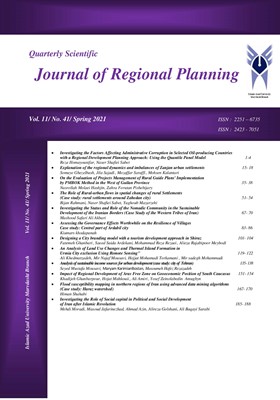نقش کاهش فرصت جرم در ارتقای امنیت محلههای شهری با استفاده از رویکرد مکانی (مطالعه موردی: محلههای سعدی و کوشک میدان، شهر شیراز)
الموضوعات : Regional Planning
علیرضا عبداله زاده فرد
1
![]() ,
روجا خسروی
2
,
روجا خسروی
2
1 - استادیار گروه شهرسازی، واحد صفاشهر، دانشگاه آزاد اسلامی، صفاشهر، ایران
2 - مربی گروه شهرسازی، واحد بیضا، دانشگاه آزاد اسلامی، بیضا، ایران
الکلمات المفتاحية: کاهش فرصت جرم, ارتقای امنیت محله, رویکرد مکانی,
ملخص المقالة :
جرم در یک تقاطع زمانی و مکانی فاقد نظارت و مراقبت، وقتی بزهکار با انگیزه و بزهدیده مناسب با هم مواجه میشوند، به وجود میآید. تا پیش از قرن بیستم تأکید جرمشناسان بر پیشگیری اجتماعی از جرم بود. تغییر جهت اساسی از عامل انسانی که جرم را به وجود میآورد به مکان یعنی جایی که جرم اتفاق میافتد، در این زمان رخ داد و رویکرد پیشگیری مکانی از وقوع جرم مطرح شد. بر اساس نظریات مطرح شده در این رویکرد با کاهش فرصت ارتکاب جرم به واسطه تغییرات در محیط میتوان امنیت را افزایش داد. بدین منظور پژوهش حاضر با هدف بررسی نقش کاهش فرصت جرم در ارتقای امنیت محلههای شهری با استفاده از رویکرد مکانی انجام گرفته است. روش مطالعه پیمایش و ابزار گردآوری دادهها پرسشنامهی محقق ساخته میباشد. دو محله سعدی و کوشک میدان واقع در شهر شیراز با توجه به قرارگیری در محدوده بافتهای ناکارآمد شهری به عنوان نمونه موردی انتخاب شدند. تعداد حجم نمونه برای هر یک از محلهها با استفاده از فرمول کوکران و با توجه به حجم جامعه تعیین گردید. دادهها توسط نرمافزارهای SPSS , AMOS تحلیل شدهاند. روش نمونهگیری «تصادفی ساده» میباشد. ضریب آلفای کرونباخ برای سنجش روایی و اعتبار پرسشنامه و روش معادلات ساختاری جهت بررسی نقش کاهش فرصت ارتکاب جرم در افزایش امنیت ساکنین محلههای شهری استفاده شده است. یافتههای تحقیق حاکی از آن است که در محله سعدی به ازای یک واحد کاهش در فرصت جرم، متغیر امنیت به میزان 0.78 ارتقا مییابد. این میزان برای محله کوشک میدان 0.63میباشد. از میان ابعاد کاهش فرصت جرم، تاثیرگذارترین بعد بر ارتقاء امنیت در محله سعدی همبستگی اجتماعی و در محله کوشک میدان، قلمروگرایی میباشند. بنابراین با دقت در میزان اثر متغیرهای فوق میتوان راهکارهای مناسب برای ارتقای امنیت در محدودههای مطالعاتی را تعیین نمود.
12. Mirjamshidian, A. and H. Nematzadeh, and S. Abbaspour, (2016): Crime prevention through environmental design. New research in management and accounting journal, Vol.2, No. 4, pp. 31-40 (in Persian).
14. Mohseni, M.R. and A. Zandiatashbar, and M. Masud, (2013): A comparative study of physical elements in Shiraz traditional districts with the features of CPTED approach. Iranian Islamic city study journal. Vol.4, Issue 13, pp.65-72 (in Persian).
15. Mostofiolmamaleki, R. and F. Bahrami, (2014): Investigating Environmental prevention of crime with CPTED approach. Danesh-E-Entezami, Vol.13, NO.3 (52), pp .135-168 (in Persian).
16. Nayebi, H. and M. Soleymani, (2017): Investigating the Relationship between Physical-Spatial Situation, Crime and Safety in Urban Spaces (case study: Sidewalks in Khorramabad city). Urban sociological studies journal.Vol.7. Issue.22, pp. 1-22 (in Persian).
17. Norozi, B. and M. Barani and M.H. Sarkeshian, (2011): Crime prevention from theory to practice with an emphasis on the role of police. Tehran, Office of Applied Police Prevention, pp. 267-322 (in Persian).
18. OshtoriFard, H. and M. Faghiye, (2015): Providing a model for preventing social worries about crime and creating social security (Case study: Residents of Tehran), Journal of Social Security Studies, Vol.2, No. 41, pp.1-22 (in Persian).
24. Tavasoli, M.H. and M.A. Sadeghi, M. (2015): Islamic teachings of crime prevention, Insight and Islamic education. Vol. 12, No. 32, pp. 42-73 (in Persian)._||_


